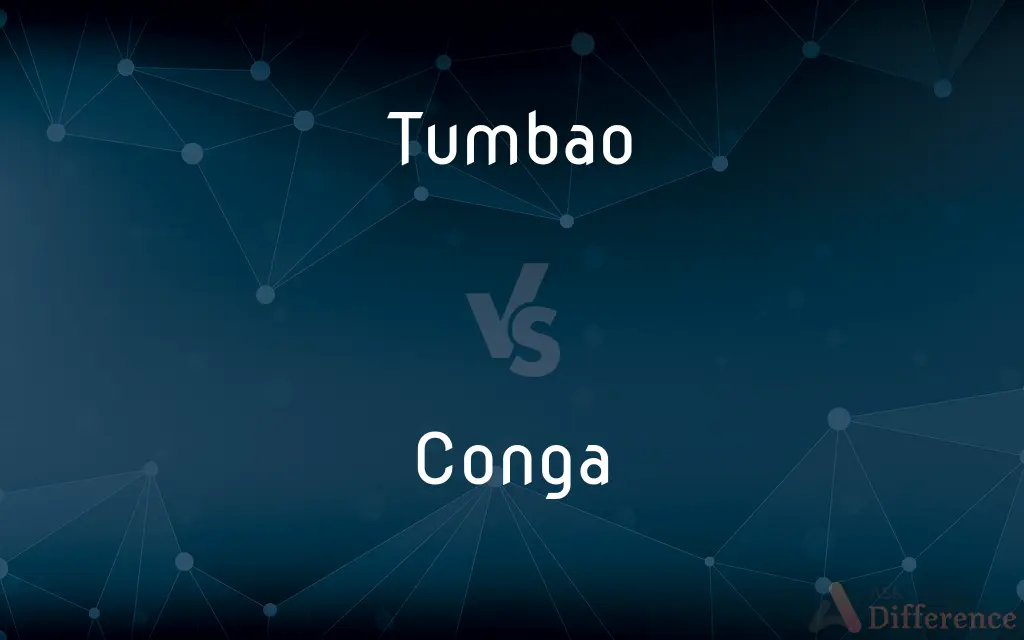Tumbao vs. Conga — What's the Difference?
By Fiza Rafique & Maham Liaqat — Updated on April 7, 2024
Tumbao is an Afro-Cuban rhythm played on congas, marked by syncopation and repetition. The conga is a Cuban drum and also refers to its music/dance genre.

Difference Between Tumbao and Conga
Table of Contents
ADVERTISEMENT
Key Differences
Tumbao is a rhythm pattern that is foundational in Afro-Cuban music, characterized by its syncopated beats and repetitive nature, often played on conga drums or other percussion instruments. This pattern serves as the backbone for various Latin music genres, emphasizing the off-beats or syncopated notes to create a distinctive groove. Conga, on the other hand, refers to both a type of drum used in Latin American music and a dance or music genre that originated in Cuba. The conga drum is known for its tall, narrow design and single-headed drum surface, played with the hands to produce deep, resonant tones. The music and dance style named after this instrument are recognized for their lively, pulsating rhythms and are often associated with Carnival celebrations.
The rhythmic structure of tumbao serves as a critical element in salsa music and other forms of Latin American music, providing a complex and engaging pattern that musicians and dancers follow. It often involves a specific interplay between the bass and conga drums, creating a polyrhythmic texture that is both challenging and invigorating. In contrast, conga rhythms are typically more straightforward, emphasizing a strong, steady beat that encourages dancing and celebration. The conga drum's sound is integral to this musical style, offering a depth and richness that enhances the overall experience.
Tumbao's complexity and versatility allow it to adapt across various genres within Afro-Cuban music, enabling it to serve as a foundational pattern that can be embellished or modified depending on the musical context. This adaptability is a testament to its importance in Latin music, providing a rhythmic framework that supports melodic and harmonic elements. Meanwhile, the conga drum, while versatile in its own right, is often associated with a more specific range of music styles, including conga music, rumba, and salsa, where it plays a central role in establishing the groove and tempo.
While tumbao emphasizes the interplay between rhythm and melody, often requiring a deeper understanding of Afro-Cuban musical traditions to appreciate its nuances, the conga drum and its associated music styles are more immediately accessible, focusing on the physical and emotional impact of the rhythm. This accessibility makes conga music and dance popular in both formal and informal settings, celebrating the communal aspect of music-making and dancing.
Despite their differences, both tumbao and conga are integral to the rich tapestry of Latin American music, each contributing to the genre's vibrancy and diversity. Tumbao, with its intricate patterns and emphasis on syncopation, offers musicians a framework for improvisation and expression. In contrast, the conga drum provides a solid rhythmic foundation that unites performers and dancers in a shared musical experience, highlighting the communal nature of Afro-Cuban music.
ADVERTISEMENT
Comparison Chart
Definition
A rhythm pattern in Afro-Cuban music.
A type of drum and a genre of dance/music.
Origin
Afro-Cuban music traditions.
Cuba, associated with both the instrument and dance.
Musical Role
Provides rhythmic foundation and syncopation.
Provides steady beats and is central to the genre.
Complexity
Often complex, with emphasis on syncopation.
Ranges from simple to complex, versatile in use.
Associated Music Genres
Salsa, rumba, and other Latin music genres.
Conga music, rumba, salsa, Carnival music.
Compare with Definitions
Tumbao
Instruments.
While often played on conga drums, tumbao can be adapted to various percussion instruments.
Conga
Instrument Description.
The conga drum is tall, narrow, and played with the hands.
Tumbao
Complexity.
Tumbao's complexity lies in its syncopation and rhythmic interplay.
Conga
Dance Style.
Conga dance is known for its lively steps and pulsating rhythms.
Tumbao
Musical Context.
In Afro-Cuban music, tumbao serves as the rhythmic foundation.
Conga
Musical Genre.
Conga music is celebrated for its upbeat and festive nature.
Tumbao
Cultural Significance.
Tumbao reflects the rich musical heritage of Afro-Cuban traditions.
Conga
Cultural Role.
The conga embodies the festive spirit of Cuban music and Carnival celebrations.
Tumbao
Rhythm Pattern.
Tumbao is characterized by its syncopated rhythm, essential in salsa music.
Conga
Versatility.
The conga drum is used across various Latin music genres, from salsa to rumba.
Tumbao
In music of Afro-Cuban origin, tumbao is the basic rhythm played on the bass. In North America, the basic conga drum pattern used in popular music is also called tumbao.
Conga
The conga, also known as tumbadora, is a tall, narrow, single-headed drum from Cuba. Congas are staved like barrels and classified into three types: quinto (lead drum, highest), tres dos or tres golpes (middle), and tumba or salidor (lowest).
Tumbao
(music) The basic rhythm played on the conga drum and the bass in Afro-Cuban music.
Conga
A dance of Latin American origin in which the dancers form a long winding line.
Conga
The music for this dance.
Conga
A conga drum.
Conga
To perform this dance.
Conga
(musical instrument) A tall, narrow, single-headed Cuban hand drum of African origin.
Conga
(dance) A march of Cuban origin in four-four time in which people form a chain, each holding the hips of the person in front of them; in each bar, dancers take three shuffle steps and then kick alternate legs outwards at the beat; the chain weaves around the place and allows new participants to join the back of the chain.
Conga
To dance the conga.
Conga
Music composed for dancing the conga.
Conga
A Latin American dance of 3 steps and a kick by people in single file.
Conga
Music composed for dancing the conga
Conga
A Latin American dance of 3 steps and a kick by people in single file
Conga
Dance the conga
Common Curiosities
What types of music use the conga drum?
The conga drum is used in various Latin music genres, including salsa, rumba, and conga music.
What is tumbao?
Tumbao is a rhythmic pattern foundational to Afro-Cuban music, emphasizing syncopation and repetition.
How does tumbao contribute to Latin music?
Tumbao provides a complex rhythmic foundation that supports melodic and harmonic elements in Latin music.
What is the cultural significance of tumbao?
Tumbao reflects the rich musical heritage of Afro-Cuban traditions, embodying the blend of African and Cuban influences.
What is the history of the conga drum?
The conga drum has roots in African drumming traditions and was developed and popularized in Cuba.
Are conga drums used in non-Latin music genres?
While primarily associated with Latin music, conga drums can be found in various musical contexts beyond Latin genres.
Can tumbao be learned by beginners?
Learning tumbao can be challenging due to its rhythmic complexity, but it is accessible with practice.
Can tumbao be played on instruments other than conga drums?
Yes, while commonly played on conga drums, tumbao can be adapted to other percussion instruments.
Is conga music suitable for beginners?
Conga music, with its straightforward rhythms, is accessible and can be enjoyed by beginners.
What is a conga drum?
A conga drum is a tall, narrow, single-headed Cuban drum, played with the hands to produce deep, resonant tones.
What makes tumbao complex?
The complexity of tumbao lies in its syncopated beats and the interplay between different rhythms.
How is tumbao used in modern music?
Tumbao continues to influence modern music, particularly in jazz, pop, and electronic genres, where its rhythmic patterns are incorporated for texture and groove.
Are there different types of conga drums?
Yes, conga drums come in various sizes, each producing different tones, commonly used together in sets.
How does conga music differ from other Latin music genres?
Conga music is characterized by its pulsating rhythms and is often associated with festive and communal celebrations.
How do tumbao and conga contribute to dance?
Both tumbao and conga provide rhythmic frameworks that inspire and guide dancers in Latin dance styles.
Share Your Discovery

Previous Comparison
Delete vs. Edit
Next Comparison
Integrity vs. StrengthAuthor Spotlight
Written by
Fiza RafiqueFiza Rafique is a skilled content writer at AskDifference.com, where she meticulously refines and enhances written pieces. Drawing from her vast editorial expertise, Fiza ensures clarity, accuracy, and precision in every article. Passionate about language, she continually seeks to elevate the quality of content for readers worldwide.
Co-written by
Maham Liaqat















































